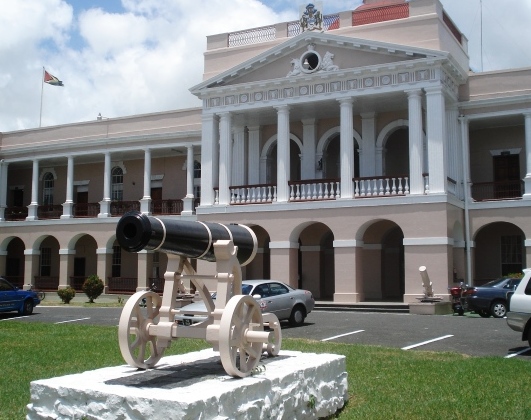Government was yesterday unable to provide details on a fund which was to be set up since 2006 for royalties accruing to indigenous peoples from mining activities on their lands.
The absence of the fund came to light after it was discovered that the revised Amerindian Act had not bee brought into force four years after it had been passed. The government hurriedly tried to remedy this by tabling a commencement bill.
The matter came up in the National Assembly yesterday when Minister of Amerindian Affairs, Pauline Sukhai led debate on the second reading of the Amerindian Act 2006 (Commencement) Bill 2010.
According to Clause 51(3) of the Amerindian Act 2006 “The Guyana Geology and Mines Commission shall transfer 20% of the royalties from the mining activities to a fund designated by the Minister for the benefit of the Amerindian Communities.”

The clause does not refer to all mining activities as was previously reported but falls within the section of the Act that deals with village lands. Clause 51(1) states that “A miner shall pay the village tribute of at least 7% of the value of any minerals obtained from village lands from small or medium scale mining.”
Clause 51(2) adds that “A miner shall negotiate in good faith with a village the amount of tribute to be paid for minerals obtained from village lands from large scale mining and in the case where the village has refused its consent, such tribute shall be agreed between the minister and the miner before the mining activities commence.”
Prime Minister Samuel Hinds, in pointing this out, said he was “astonished” at the interpretation reported in the press but did not address the whereabouts of the money. Sukhai also ignored the issue in her two contributions to the debate despite calls from opposition members for the government to account for the money. When approached by this newspaper at the break for a comment she told the reporter to listen to the debate.
PNCR Shadow Finance Minister Winston Murray accepted Hinds’ explanation of the origins of the fund but took him to task for not addressing the central issue of the whereabouts of the money.
“Won’t it have been nice to tell us that the fund was created on such and such a day and the fund exists in this bank account under this ministry’s control and that the fund has x million dollars in it?” he queried.
He added that the government should have created the fund in the same good faith it said it was acting as it pursued the other provisions of the Act which was not in force.
“Prime Minister, let us before the end of next week hear the details of the fund; tell us in which account it is, how much money there is and what are the procedures for accessing it and then we will believe you,” Murray declared.
His call seemed to find favour with the Prime Minister who nodded and signalled by gesturing that he would do so.
When approached after the sitting for a comment on the status of the fund, Hinds, who has responsibility for mining, said the GGMC had the money and was prepared to pay it over as soon as the fund was in place, an echo of an earlier comment by GGMC Legal Advisor Rosemary Benjamin-Noble which this newspaper reported yesterday. However, sources have since pointed out that there are no provisions in GGMC’s accounts for such a fund. Benjamin-Noble was not available yesterday to respond to this point.
Referring to the possibility of the monies benefiting all indigenous communities, Hinds added that its distribution will have to be examined most likely by the National Toshaos Council (NTC).
“If you look in the Stabroek News commentary on Monday you’d see there’s an implied issue where they talk about these monies should not go [only] to the villages which have mining but to everybody and I think that’s an area that has to be discussed as to how the monies will be distributed.”
The Monday editorial had queried whether NTC Chairperson Yvonne Pearson had enquired about “the quantum of the fund and how it could be applied to the benefit of all of the communities as opposed to just a few of the favoured.”
The issue first surfaced in September when chartered accountant and attorney Christopher Ram in a letter to Stabroek News pointed out that the Amerindian Act of 2006 had not been in force all these years even though it had been passed in parliament and the government on numerous occasions referred to it as evidence of its respect for the rights of the indigenous peoples.
He posited that a possible reason why the act was not brought into force was because of the GGMC’s obligation to transfer the 20% in royalties.
Sukhai yesterday slammed the misinterpretation of Clause 51(3) saying it was an attempt to “mislead the nation.” However, Murray in his presentation noted that the matter may never have surfaced had it not been for Ram.
“Let us not discredit Mr. Ram; Mr. Ram is the person who brought this fact to attention and presented us with the opportunity to correct it so at a minimum he deserves credit for that so let us not try to throw away the baby with the bathwater every time we speak,” the PNCR-1G frontbencher stated.
In the wake of Ram’s revelation the government last week tabled the Commence-ment Bill in the National Assembly where it was passed last evening.
According to the Explanatory Memorandum, the Bill seeks to validate the commencement of the Amerindian Act 2006 with effect from March 14th, 2006. “It validates all acts and things done between 14th March, 2006 and the enactment of this Act which would have been lawful if the Amerindian Act 2006 had been brought into force by Order. All persons are freed, acquitted, discharged and indemnified from all liability and legal proceedings of any kind in respect of acts and things done between the 14th
March, 2006 and the enactment of this Act”, it says.
It says that no person shall be held guilty of a criminal offence on account of any act or omission and no person shall be made or shall become liable to any penalty in respect of any act of commission or omission under the Amerindian Act 2006 between 14th March and the enactment of the Bill.
According to the Explanatory Memorandum, an order was made bringing the Amerindian Act 2006 into force in April 2006. “This order was signed by the Minister but a Gazette copy cannot be found. Hence it is necessary to proceed by way of an amendment Act to bring the Amerindian Act into force and to effect the necessary validation”, it says.
But Murray last night also argued that the commencement bill could be challenged since the Act specified that it be brought into force by commencement order.
“What is written in the Amerindian Act does not go away, it still requires the minister to bring the Act into operation by order, this is not an order this is a bill that is being brought here so we have a conflictual situation here and this I posit … is challengeable,” Murray said.
In closing the debate Minister Sukhai said she was advised by the Attorney General’s Office that the commencement bill would “serve the purpose” and that was the basis on which it was brought before the House.
Government representatives said the failure to ensure the Act was in force was a result of human error which they sought to link to the chaotic times that ensued following the April 2006 killing of Minister Satyadeow Sawh and the holding of General Elections that year.






